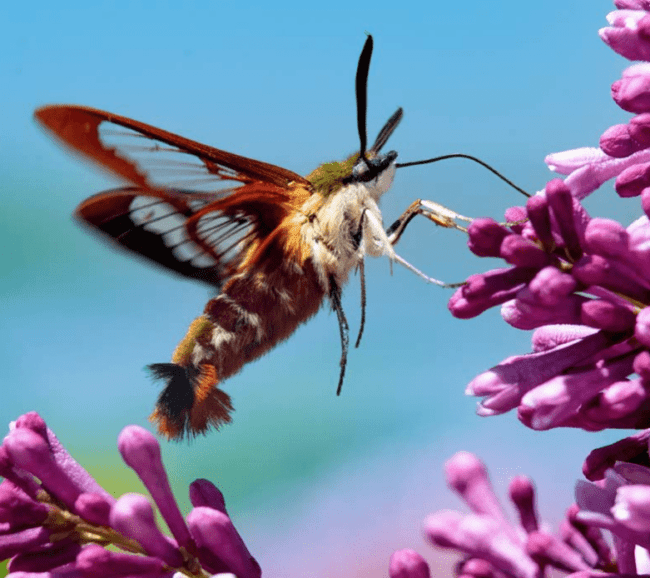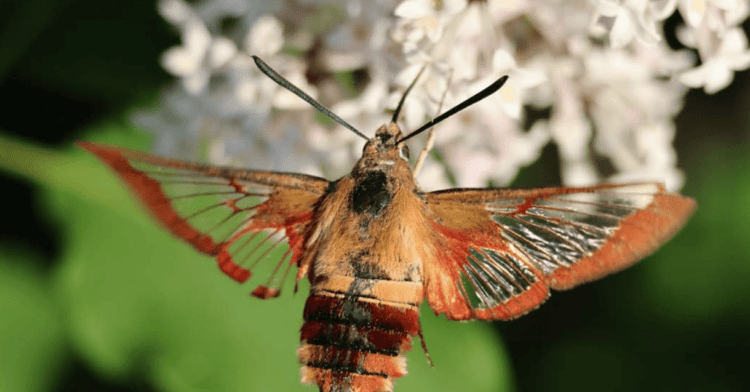“Check out the hummingbird!” the excited siblings called out in near unison as they admired the zoo’s pollinator gardens at summer’s end with their parents.
“Wait, that’s not a bird,” the little boy called out.
“What is that thing?” his big sister asked, scrutinizing the mesmerizing creature hovering just an arm’s length away.
What they beheld is a marvel living in our midst. The Hummingbird moth, also known as the Hummingbird Clearwing, Clearwing moth, or Clearwing Sphinx moth, Hemaris thysbe, is a chimeric creature that combines traits of a multitude of species. With a stout, spindle-shaped body up to 2 inches in length and a broad wingspan reaching 2 ¼ inches, the Hummingbird moth approaches the size of the species it mimics in function—the Ruby-throated hummingbird—and is hard to miss. Golden-olive dorsally and creamy-yellow ventrally with a dark burgundy abdomen, this moth boasts bright coloration, yet its namesake wings are stunning. With a blurring speed of up to 85 wing beats per second, the Clearwing moth’s four wings produce wing strokes in a shallow figure-eight motion which are literally faster than the human eye and even produce an audible hum! After several flights, such speed results in the sloughing of the moth’s wing scales—producing clear wings rimmed by deep burgundy wing borders. Among its more unusual traits is a lobster-like “tail fan” which aids the insect in remarkable maneuverability.
Adopting a hummingbird-like lifestyle in which it hovers above blooms, zipping from flower to flower, the Clearwing moth extracts nectar from deep-tubed flowers, unfurling its long tongue-like proboscis—twice the length of its body! Due to this feeding strategy, the moth can access flowers other insect species cannot, pollinating new plants with each feeding. Even more significantly, as a diurnal moth species, which is rare in North America, these insects can access flowers in bloom that would be closed at night. With roughly 125 Hummingbird moth species living in North America and more than 1,500 worldwide, the family is diverse and phenomenally successful.
Feeding on a wide variety of plants including cherries, and plums as caterpillars and Beebalm, Snowberry and Blueberry as adults, Clearwing moths feed on a diverse number of plant species enabling them to range from Alaska southward to Oregon in the west and from Newfoundland and Ontario southward through Florida in the east.
 With the flight of a hummingbird, the tail of a lobster and the daytime habits of a butterfly, the Clearwing moth possesses diverse physical and behavioral traits which imbue it with advantages over the competition. What’s more, the Clearwing possesses modified hairs which resemble fine hummingbird-like feathers which shine in the sun and distinctly bird-like eyes.
With the flight of a hummingbird, the tail of a lobster and the daytime habits of a butterfly, the Clearwing moth possesses diverse physical and behavioral traits which imbue it with advantages over the competition. What’s more, the Clearwing possesses modified hairs which resemble fine hummingbird-like feathers which shine in the sun and distinctly bird-like eyes.
While the vast majority of moths are nocturnal, the Clearwing prefers to feed in the bright daylight. In response, its eyes have developed some unusual, “Un mothlike” features. Specifically, the center of its eye is tightly packed with more photoreceptors cells than the edges. This enables the Clearwing to see greater detail in the objects immediately in front of it. This likely evolved to help the moth judge its distance from long-stemmed flowers, enabling it to target and access such flowers which bob and sway in the wind. Additionally, the Clearwing possesses a pseudo pupil—giving it the appearance of a bird’s eye which gives potential predators the warning that they have been spotted and are under observation. This “blows the cover” of the predator’s ambush, buying the Clearwing time to escape.
While its design enables it to pollinate a multitude of species, it also equips it with the speed and maneuverability to evade nearly all predators. Then, there is the magical. Named after Ovid’s beauty Thisbe, the Clearwing is indeed an arresting creature. In addition to evading predators, these utterly unique creatures evade convention and our perception alike. With wing speed exceeding our vision and the ability to hover motionless and reverse direction in an instant, the Clearwing moth approaches the ethereal. To witness one hovering over a flower with the morning sun sparkling off its bright fur and streaming through its crystalline wings is to behold the pinnacle of Mother Nature’s engineering and beauty in an instant.
In the Clearwing moth we have a creature worthy of emulation. How many advantages can we harness by defying convention? What lies within our grasp when we adopt the traits of those who accomplish amazing feats? What sort of mesmerizing chimeras can we become? With purpose shaping our efforts, the answers are as clear as the wings that bring us to our next bright bloom.
Jim Knox serves as the Curator of Education for Connecticut’s Beardsley Zoo where he leads conservation education initiatives. A Member of The Explorers Club, Jim enjoys sharing his passion for wildlife with audiences in Connecticut and beyond.





